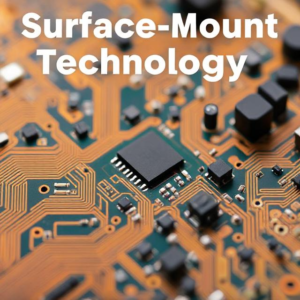What is Surface-Mount Technology (SMT)?
Surface-Mount Technology (SMT) is a method used in electronics to mount components directly onto the surface of a printed circuit board (PCB), instead of using holes to insert the components through the board.
In simpler terms, instead of placing parts inside the PCB, with SMT, the components sit on top of the PCB and are soldered directly to it. SMT makes it easier and faster to assemble electronic devices like smartphones, computers, and TVs.

Why is SMT Important?
SMT has become the standard for manufacturing electronic devices because it offers many benefits over older methods like Through-Hole Technology (THT), where components are inserted through holes in the PCB.
How Does SMT Work?
Here’s a step-by-step process of how SMT is used in electronics:
- Designing the PCB:
- The PCB is designed with pads (small metal areas) where the components will be placed. These pads are for the electrical connections needed for the components to work.
- Placing the Components:
- Instead of inserting the leads (wires) of the components through holes in the PCB (as in traditional methods), SMT components have flat metal leads or terminals that sit on top of the PCB.
- Machines, called pick-and-place machines, pick up the small components and place them accurately on the PCB.
- Soldering the Components:
- Once all the components are in place, the PCB is passed through an oven in a process called reflow soldering.
- The oven heats up, causing the solder paste (a mixture of tiny metal balls and flux) to melt and form a solid electrical connection between the component and the PCB.
- Testing:
- After soldering, the board goes through testing to make sure all components are connected properly and the circuit works as expected.
Types of SMT Components:
SMT components are smaller and more compact than the traditional ones, making them easier to fit into modern devices. Common SMT components include:
- Resistors: Limit the flow of electricity in a circuit.
- Capacitors: Store electrical energy.
- Diodes: Allow electricity to flow in one direction.
- Transistors: Act like a switch to control the flow of electricity.
- Integrated Circuits (ICs): Tiny chips that can perform many functions, such as processing data.
Advantages of SMT:
- Smaller Size:
- SMT components are much smaller than traditional components, which allows for more components to be packed into a smaller space. This helps in making smaller devices like smartphones, tablets, and wearable gadgets.
- Faster Production:
- SMT allows for automated assembly using machines to place and solder the components quickly. This results in faster production compared to manual assembly or older techniques.
- Higher Performance:
- Since SMT components are placed directly on the surface, they have shorter electrical paths (less distance for electricity to travel), which can improve the performance of the circuit.
- Cost-Effective:
- SMT requires fewer manual steps and less space for components, making it a more affordable manufacturing process, especially for mass production.
- Better Durability:
- SMT components are generally more reliable and durable because they are less likely to get damaged from mechanical stress, as they don’t have leads sticking out of the PCB.
SMT vs. Through-Hole Technology (THT):
- Through-Hole Technology (THT): In this older method, components have long legs that go through holes in the PCB. The legs are then soldered on the opposite side of the board. This method is bulkier, and the components are larger.
- Surface-Mount Technology (SMT): Components are much smaller and sit directly on the surface of the PCB, making the board thinner and more compact.
Real-World Applications of SMT:
SMT is used in almost all modern electronics. Some examples include:
- Smartphones: SMT allows manufacturers to pack many components into a small space, making smartphones slim and powerful.
- Laptops and Tablets: These devices have a lot of small components that are mounted on the PCB using SMT.
- Home Appliances: Many home appliances, like washing machines, microwaves, and TVs, use SMT to make them compact and reliable.
- Medical Devices: SMT is used in devices like pacemakers, blood pressure monitors, and diagnostic equipment.
Summary:
- Surface-Mount Technology (SMT) is a method of assembling electronic components on the surface of a printed circuit board (PCB), instead of through holes.
- SMT components are smaller, more reliable, and more cost-effective than older Through-Hole Technology.
- The process involves placing components on the board, soldering them in place, and then testing the circuit.
- SMT has many advantages, including faster production, smaller size, and better performance, making it ideal for modern electronics like smartphones, computers, and medical devices.
SMT has revolutionized the way electronic devices are made, helping create smaller, faster, and more reliable gadgets.
Tags: automated assembly, automated soldering, blood pressure monitors, capacitors, circuit design, circuit reliability, compact components, compact PCB design, component placement, Computers, cost-effective manufacturing, data processing chips, diagnostic equipment, Diodes, durable electronics, efficient electronics, electrical connection, electrical pads, electronic assembly, electronic manufacturing process, Electronics, electronics industry, faster production, flat metal leads, Functional testing, High performance, high-speed assembly, home appliances, ICs, Integrated Circuits, laptops, leaded components, mass production, mechanical stress resistance, medical devices, miniaturization, modern electronics., modern gadgets, pacemakers, PCB, PCB testing, pick-and-place machines, Printed Circuit Board, reflow soldering, Resistors, short electrical paths, slim gadgets, smaller size, smartphones, SMT, SMT advantages, SMT vs THT, solder paste, Surface Mount Technology, surface mounting, surface-mounted components, tablets, Through-Hole Technology, THT, transistors, wearable devices


